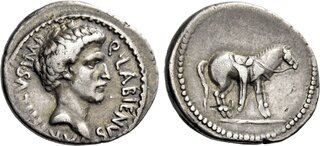| Numismatica Ars Classica > Auction 146 | Auction date: 8 May 2024 |
| Lot number: 2315 Price realized: This lot is for sale in an upcoming auction - Bid on this lot  | Show similar lots on CoinArchives Find similar lots in upcoming auctions on |
| Lot description: Q. Labienus Parthicus. Denarius, mint moving with Labienus in Asia Minor 40, AR 19 mm, 3.80 g. Q LABIENVS – PARTHICVS IMP Bare head of Labienus r. Rev. Parthian horse r., with bridle and saddle, to which bow case and quiver are attached. Babelon Atia 3. C 2. Sydenham 1357. Sear Imperatores 341. Hersh, in SNR 59, 1b (this coin). RBW 1809. Crawford 524/2. Extremely rare. A pleasant specimen of this desirable issue. A lovely portrait struck on excellent metal and with a lovely old cabinet tone. A banker's mark on reverse, otherwise good very fine Ex Ars Classica XI, 1925, Levis, 171; Glendining's 24 November 1948, Sydenham, 401; Glendining's 20 November 1969, Baldwin, 10 and Marti Hervera and Soler & Llach 1122, 2021, 492 sales. The imperatorial age offered much opportunity to ambitious commanders, as anyone who could lead men in battle was a valued commodity. Loyalty was not always the most valued trait in this environment, for on many occasions defections were not only sensible, but invited, and rewarded. We tend to degrade traitors in the historical tradition, but we often are not privy to the multitude of factors faced by these men, which ranged from subtle personality conflicts to unexpected political developments. It is in this charitable light, perhaps, that we should judge Labienus, one of the vigorous commanders from the age of Antony, Octavian and Sextus Pompey. Originally Brutus and Cassius had sent Labienus to Parthia to seek support from king Orodes II, but he could not achieve his objective before his masters were defeated at Philippi in October, 42 B.C. Labienus was thus in a bind, being unable to return to the West. Rather than facing his punishment, Labienus switched strategies by encouraging Orodes II to invade Syria, with himself sharing the command with the king's son, Pacorus I. The invasion probably began early in 40 B.C. when Antony was torn between that calamity cided to sail westward to meet Octavian and, in the meantime, many cities and legions defected to Labienus, who presented himself as the last ember of the Republican cause. He and Pacorus initially defeated Antony's governor Lucius Decidius Saxa, and then they divided their forces: Labienus invaded Asia Minor and Pacorus drove into Palestine and Phoenicia. Alarmed by their success, early in 39 B.C. Antony sent his lieutenant Ventidius to restore order, which he did with great efficiency. He first captured and executed Labienus at the Cilician Gates in 39 B.C. and soon afterward chased Pacorus and his army back across the Euphrates. This famous denarius bears a portrait of the unfortunate Labienus, identified by his name, the title imperator, and the cognomen Parthicus, which he adopted as an expression of his success in gaining Parthian help in what he branded as the defence of the Republic. The reverse bears no inscription, but shows a bridled horse fitted with a saddle and bow-case; there can be little doubt that this represents the cavalry contingent of the invasion force, which was 20,000 strong. In essence it honours the famous Parthian cavalry, and in that regard we may see this as a coin of two cultures, with the obverse devoted to the Romans, the reverse to the Parthians. and an equally urgent situation in the West, where his brother Lucius had been defeated by Octavian in the Perusine War. Antony decided to sail westward to meet Octavian and, in the meantime, many cities and legions defected to Labienus, who presented himself as the last ember of the Republican cause. He and Pacorus initially defeated Antony's governor Lucius Decidius Saxa, and then they divided their forces: Labienus invaded Asia Minor and Pacorus drove into Palestine and Phoenicia. Alarmed by their success, early in 39 B.C. Antony sent his lieutenant Ventidius to restore order, which he did with great efficiency. He first captured and executed Labienus at the Cilician Gates in 39 B.C. and soon afterward chased Pacorus and his army back across the Euphrates. This famous denarius bears a portrait of the unfortunate Labienus, identified by his name, the title imperator, and the cognomen Parthicus, which he adopted as an expression of his success in gaining Parthian help in what he branded as the defence of the Republic. The reverse bears no inscription, but shows a bridled horse fitted with a saddle and bow-case; there can be little doubt that this represents the cavalry contingent of the invasion force, which was 20,000 strong. In essence it honours the famous Parthian cavalry, and in that regard we may see this as a coin of two cultures, with the obverse devoted to the Romans, the reverse to the Parthians. Estimate: 30000 CHF |  |



